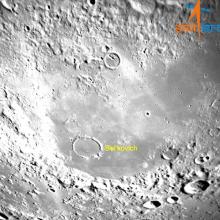Listen to today's episode of StarDate on the web the same day it airs in high-quality streaming audio without any extra ads or announcements. Choose a $8 one-month pass, or listen every day for a year for just $30.
You are here
Moon and Venus
There’s no air on the Moon, so there’s no wind or rain to alter the surface. Yet the Moon does have weather — space weather. A steady “rain” of tiny space rocks pounds the surface, breaking up the rocks and forming a powdery dirt known as regolith. And charged particles from the Sun can change the chemistry of the rocks and regolith, turning them darker.
Interactions with the Sun may have other effects as well.
Some recent work, for example, found that big solar storms may induce a sort of “lightning” in regions that receive little sunlight. The solar storms produce lots of particles with an electric charge, which can embed themselves in the regolith. The positively charged particles are entire atoms, so they go deeper than the negatively charged particles, which are lightweight electrons. Like the electric charges within clouds, that can trigger sparks. In this case, the sparks may melt some of the regolith.
Some regions of the Moon may be shielded from solar particles by areas with weak magnetic fields. When the solar wind streams by, the magnetic field may create an electric current that deflects the charged particles. Since these regions are protected, the regolith doesn’t get darkened as much. That creates bright swirls on the surface — regions that haven’t felt the impact of space weather.
Look for the Moon before sunrise tomorrow, with Venus, the “morning star,” to its lower left. More about Venus and the Moon tomorrow.
Script by Damond Benningfield






